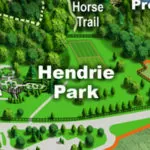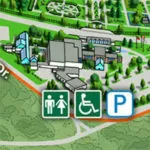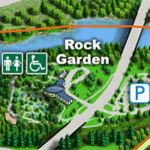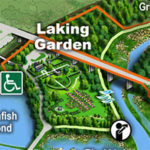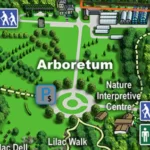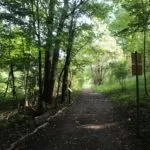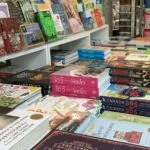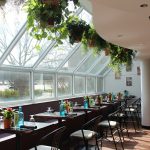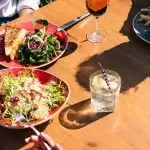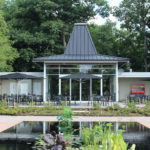| Membership | Price |
|---|---|
| Student | $55/year |
| Single | $85/year |
| Single Plus | $120/year |
| Family | $130/year |
| Family Plus | $175/year |
| Contributing | $250/year |
| Supporting | $500/year |
| Sustaining | $1,000/year |
| Benefactor's Circle | $2,500/year |
| Director's Circle | $5,000/year |
| President's Circle | $10,000/year |
Seeing the Invisible
This Event Has Passed
This listing is for a 2021/2022 event. For future events and programming happening at RBG, check out rbg.ca/events
Encounter incredible augmented reality art throughout the beautiful Hendrie Park landscape!
Seeing the Invisible features augmented reality (AR) works by more than a dozen international artists including Ai Weiwei, Refik Anadol, El Anatsui, Mohammed Kazem, Sigalit Landau, Sarah Meyohas, Pamela Rosenkranz, and Timur Si-Qin—including several artists’ firsts works in AR. Visitors will engage with Seeing the Invisible via an app designed for the exhibition downloadable to smartphones and tablets. This highly immersive experience will amaze visitors as they walk into and around the 13 larger than life and moving artworks.
The first exhibition of its kind to be developed as a collaboration among botanical gardens around the world, Seeing the Invisible was initiated by the Jerusalem Botanical Gardens and Outset Contemporary Art Fund with support of The Jerusalem Foundation, and is co-curated by Hadas Maor and Tal Michael Haring.
Generously supported by:



Hours reflect garden admission availability at Hendrie Park. When selecting a time to visit, consider high-sun may impact visibility on your device screen.
June 2 to August 31: 10 a.m. to 8 p.m.*
*Exceptions: Seeing the Invisible access to Hendrie Park will close early on the following dates for the Arts After Hours events.
10 a.m. to 5:30 p.m. (last admission 4:30 p.m.):
- Monday June 27
- Wednesday July 13
- Wednesday July 27
- Wednesday August 10
- Friday August 26
September 1 to 18: 10 a.m. to 5 p.m.
Final admission: 4 p.m.
Works and Artists
Learn more about the augmented reality works in the exhibit and the artists who created them. Tap the name for more information.

Ai Weiwei, Gilded Cage AR, 2021
b.1975, China
Lives and works in multiple locations, including Beijing (China), Berlin (Germany), Cambridge (UK) and Lisbon (Portugal)
Gilded Cage is an iconic work by multidisciplinary artist and activist Ai Weiwei, originally created in 2017 as part of a global migration campaign titled Good Fences Make Good Neighbors (a line taken from the 1914 poem Mending Wall by acclaimed American poet Robert Frost). Meticulously translated into the medium of AR and augmented into the different botanical gardens, this large-scale gilded cage addresses power structures, habitats, borders, confinement, and restriction, but also care giving, preservation, and nurturing. The work invites viewers to enter and walk through it, experience the different cells and turnstiles, while viewing the gardens from within, through its gilded bars, as a captured bird or an imprisoned man would.
Ai Weiwei is a multimedia artist who also works in film, writing, and social media. Major solo exhibitions include Serralves Museum, Porto, Portugal ; Cordoaria Nacional, Lisbon; Imperial War Museum, London; K20/K21, Düsseldorf; OCA, São Paulo; CorpArtes, Santiago; Mucem, Marseille; Fundación PROA, Buenos Aires; Sakip Sabanci Museum, Istanbul; Public Art Fund, New York; The Israel Museum, Jerusalem; Palazzo Strozzi, Florence; 21er Haus, Vienna; Helsinki Art Museum; Royal Academy of Arts, London; Martin Gropius Bau, Berlin; Hirshhorn Museum and Sculpture Garden, Washington D.C.; Taipei Fine Arts Museum; and Tate Modern, London.
Courtesy of the artist.

Refik Anadol, Machine Hallucinations: Nature Dreams AR, 2021
b. 1985, Turkey
Lives and works in Los Angeles, USA
Refik Anadol’s work is based on a series of synesthetic reality experiments centered on how human-machine collaborations can help us experience nature in a new way. The journey starts with a sophisticated Artificial Intelligence algorithm trained on 68,986,479 million raw images of nature. Utilizing the dataset as pigment and AI as his collaborator, Anadol re-creates shapes, patterns, and colors of nature, transforming them into a hypnotic cycle of deconstruction and reconstruction of natural imagery, morphed into an AI “stream of consciousness.” The work is thus based on images of nature, yet offers an alternate reality that can only be seen through a mechanical lens. As viewers gaze into the machine’s mind, they are left to wonder about a future world where nature no longer exists and technology becomes the only way of remembering.
Refik Anadol is a media artist, director, and pioneer in the aesthetics of data and machine intelligence. Preferring difference over singularity and movement over stasis, his work locates creativity at the intersection of humans and machines. Anadol’s site-specific AI data sculptures, live audio/visual performances, and immersive installations take many forms, encouraging viewers to rethink their engagement with the physical world, its temporal and spatial dimensions, and the creative potential of machines.
Courtesy of the artist.

El Anatsui, AG + BA (AR), 2014/2021
b. 1944, Ghana
Lives and works in Nigeria
El Anatsui’s iconic bottle-cap installations are created from thousands of aluminum bottle-tops wired together with copper, thereby catalyzing the transformation of familiar, mundane objects into startlingly poetic works of art. The frugality of the materials stands in contrast to the shimmering and grandiose effect they accumulate through the artistic process and manner of installation as large-scale hanging sculptures.
For this exhibition, a two-part work has been translated to AR, inserting light movement into the flexible materials. Installed in the open space of the gardens, the work accumulates gentle movement, as if soft breezes blowing through the gardens play over its surfaces. Like many of Anatsui’s pieces, the work addresses both artistic and political issues, and resonates with notions that confound art and craft, high and low, center and periphery.
Anatsui’s works are held in major international collections, including The British Museum, London; Centre Pompidou, Paris; de Young Museum, San Francisco; The Metropolitan Museum of Art, New York; National Museum of African Art, Smithsonian Institution, Washington D.C.; Kunstpalast, Düsseldorf; Tate Modern, London; and many others. Large-scale external installations include: Ozone Layer and Yam Mound at the Alte Nationalgalerie, Berlin (2010); Broken Bridge I at Musée Galliera, Paris (2012); Broken Bridge II on the High Line, New York (2012/13); and TSIATSIA – Searching for Connection (2013), his largest bottle-cap work to date. This shimmering tapestry of light embellished the façade of the Royal Academy of Arts, London, during its 245th Summer Exhibition.
Courtesy of October Gallery, London and Goodman Gallery, Johannesburg, Cape Town, London.

Ori Gersht, Forget Me Not, 2021
b. 1967, Israel
Lives and works in London, UK
Ori Gersht’s work toys with classic art historical conventions by evoking a 17th-century Dutch still life through hyper-realistic digital creation. The work presents a lush, sensuous bouquet of flowers set amidst the botanical gardens, accompanied by an accelerating bee hum that becomes almost unbearable. When the visitors are at touching distance, a violent explosion occurs, and the bouquet shutters into pieces that fill the air with fragments of glass, petals, stems, and insects, cascading slowly to the ground. The still-life image, created after Jan Brueghel the Elder’s painting Flowers in a Wooden Vessel (1606/7), is dynamically transformed into an animated Abstract Expressionist composition. Alluding to both the creation of the universe and the concept of vanitas (signifying the inevitability of death and the transience of all earthly things), Gersht’s work stands as a spectacular meditation on the infinite cycle of creation and destruction. Soon after the explosion, the voices of three scholars are heard, whispering in the grim void, as if carried by the wind; describing the once lush bouquet from a personal point of view, they offer different interpretations of the original painting that disappeared in the folds of time.
The work was developed from an earlier work by Gersht, Big Bang (2006), originally commissioned by the Victoria & Albert Museum for the 2006 exhibition Twilight, subsequently featured in Santa Monica, Boston, Washington, Germany, and the National Gallery, London. Gersht’s work has been recently featured in a number of exhibitions, including Unearthed: Photography’s Roots, Dulwich Picture Gallery, UK; Flowers in Art, ARKEN Museum for Modern Art, Denmark; and The Expanded Landscape, Getty Center, The J. Paul Getty Museum, California; among others. His solo show titled Becoming will open at the Yancey Richardson Gallery, New York in October 2021.
Text and audio recordings by:
Ronni Baer, art historian, a scholar of Dutch, Flemish art, previously the senior curator of European painting at the Museum of Fine Arts, Boston, and currently a distinguished curator and lecturer, Princeton University Art Museum. Alex Moore, head of exhibitions and creative producer at Dulwich Picture Gallery, UK. Curator of the exhibition Unearthed, unfolding the pioneering story of botanical photography since 1840. Yoav Rinon, professor of classical studies and comparative literature at the Hebrew University of Jerusalem, Israel.
Courtesy of the artist.

Isaac Julien CBE RA, Stones Against Diamonds (Ice Cave) AR, 2015/2021
b. 1960, UK
Lives and works in London, UK
Isaac Julien’s Stones Against Diamonds (Ice Cave) draws inspiration from a letter written by Brazilian architect Lina Bo Bardi and was shot in Iceland’s remote ice caves in the Vatnajökull region. Over five days, the crew endured sub-zero temperatures in the heart of spectacular, glistening glacial caves formed in ice over thousands of years and only accessible a few days a year due to the harsh climate.
Thus, the artwork explores themes inspired by Bo Bardi’s letter, where she praises the beauty of semi-precious gems over preferred precious stones such as diamonds. Julien portrays some of the most beautiful objects as the least precious in a conventional sense. Signature elements of Bo Bardi’s work have been incorporated into Stones Against Diamonds (Ice Cave), including a staircase built by hand into the ice cave during the production of the film. Continuing the parallels, Julien integrates Bo Bardi’s trademark glass and concrete easels into his film.
Augmenting a five-screen version of Stones Against Diamonds (Ice Cave) into the different botanical gardens lends it additional layers by juxtaposing distant and near. In doing so, ecosystems’ characteristics are questioned: in their relative temperature – the cold and the warm digitally meeting – but also with regards to notions of natural and cultural, cultivated and wild.
Isaac Julien is a Turner prize-nominated artist and filmmaker; recipient of the Royal Academy of Arts Charles Wollaston Award; appointed a Commander of the Order of the British Empire (CBE) in 2017. He creates multi-screen film installations and photographs that incorporate different artistic disciplines to create a unique, poetic visual language. Recent exhibitions include a solo show at MAXXI, Rome, where Julien exhibited his series entitled A Marvellous Entanglement, and the very recent European premiere of his ten-screen installation Lessons of the Hour, at the National Galleries of Scotland (Modern One), heading the Edinburgh Art Festival.
Courtesy of the artist.

Mohammed Kazem, Directions (Zero), 2010/2021
b. 1969, Dubai, UAE
Lives and works in Dubai, UAE
In Mohammed Kazem’s monumental work, viewers are invited to pass through a large-scale figure of the number zero on which numerous geographic coordinates, representing all countries of the world, are inscribed in numeric form. The work is based on the significance of the number zero – one of the first important innovations by a Muslim scientist. The course of history was changed when Persian scholar Muhammad Ibn Musa Al-Khwarizmi discovered the number zero and considered it a number within the field of algebra.
Originally conceived for the United Arab Emirates and the metropolitan city of Abu Dhabi, whose population is comprised of a diversity of nationalities, races, and religions, the work embodies the principle of coexistence and peace, inviting viewers to pass through it, as if starting anew from equal ground. As the day progresses, light, shadows, and reflections over the digital structure change, further enhancing the connection between the work and its natural surroundings.
Mohammed Kazem’s artistic practice spans video, photography, and performance, seeking new ways of apprehending his environment and experiences. The work is informed by his training as a musician. He was a member of the Emirates Fine Arts Society and is one of the Five, an informal group of Emirati artists at the vanguard of conceptual and interdisciplinary art practice.
Kazem has participated in numerous group shows, in Abu Dhabi, New York, Gwangju, Houston, etc. In 2013 he represented the UAE at the Venice Biennale with an immersive video installation entitled Walking on Water, curated by Reem Fadda, and in 2015 he showcased works from the Tongue series at 1980 – Today, curated by Hoor Al Qasimi.
Courtesy of the artist.
![Seeing The Invisible - Sigalit Landau - Salt Stalagmite #1 [Three Bridges] Sigalit Landau - Salt Stalagmite #1 [Three Bridges]](https://rbg-1c124.kxcdn.com/app/uploads/SIGALIT-300x300.jpg?x14255)
Sigalit Landau, Salt Stalagmite #1 [Three Bridges], 2021
b. 1969, Israel
Lives and works in Tel Aviv, Israel
For over fifteen years, the Dead Sea has been a source of inspiration and a laboratory for Sigalit Landau’s video works, photographic series, and salt sculptures. Relying on her unique, innovative use of Dead Sea minerals, as manifested in so many of her physical works over the years, Salt Stalagmite #1 [Three Bridges], derives from Landau’s original idea of building a floating salt bridge over the Dead Sea to connect Israel, the Palestinian Authority, and Jordan. A symbol of hope and collaboration in the Middle East, this beautiful poetic utopian idea, conceived in 2010 and nourished by a wild political imagination, is yet to be realized on site. In its current AR manifestation, the work combines a tall salt stalagmite and a set of three salt bridges, offering viewers endless routes of exploration around the work and inside its hidden creeks. It touches on the notion of the bridge as a means of passage, a medium connecting people, cultures, and languages, and activating peace.
Sigalit Landau first came to international attention when she participated in Documenta X, Kassel in 1997. Over the past two decades, she has had numerous exhibitions in leading venues around the world, including KW, Berlin; MoMA, New York; the Israeli Pavilion at the 54th Venice Biennale; SCAD Museum of Art, Savannah, Georgia; and MACBA Museu d’Art Contemporani de Barcelona.
Courtesy of the artist.

Daito Manabe, Morphecore Prototype AR, 2021
b. 1976, Japan
Lives and works in Tokyo, Japan
Daito Manabe’s work presents an endlessly dancing digital figure, continuously morphing into new shapes, moving beyond any logic of physics or laws of the universe. Extracted from MRI scans of the artist’s brain, raw brainwave data is translated into digital movement that manipulates and choreographs Manabe’s 3D-scanned human body, alongside visual noises and glitches generated by distracting thoughts in the brain. The work thus presents a new potential relation between the brain and the body, emphasizing the ability of the mind to move into the infinite, while the body is still bound to physical limitations of motion, gravity, volume, shape, and form.
Daito Manabe is an artist, programmer, and DJ. His works branch into a variety of fields and take a new approach to everyday materials and phenomena. His practice is informed by careful observation and a quest to discover and elucidate the essential potentialities inherent to the human body, data, programming, computers, and other phenomena, thus probing the interrelations and boundaries delineating the analog and the digital, the real and the virtual.
Courtesy of the artist.

Sarah Meyohas, Dawn Chorus, 2021
b. 1991, USA
Lives and works in New York City, USA
In Sarah Meyohas’s work a player piano is set in the open garden, while birds fluttering around it seem to trigger a series of musical phrases with each moment of contact. Watercolors bloom across the surface of the piano, visualizing the movement of the birds as well as the sound waves that emanate from the vibrating strings. The viewer is initially triggered by the appearance of a single bird as an invitation to follow through and reveal the full work – a musical performance orchestrated by the seemingly uncultured.
Meyohas centers her practice within emerging technologies. Working in media ranging from cryptocurrency to augmented reality, she enlists the natural world as a reference, network as medium, and the specular as a mode of contemplation. By merging traditional mythologies and clichéd objects of beauty with contemporary digital media, Meyohas enacts a visual language for the systems, algorithms, and technologies that influence our daily lives.
Sarah Meyohas has exhibited her work internationally, with solo exhibitions in New York at Red Bull Arts and 303 Gallery. Her work has traveled to institutions, including the Barbican, London; Jameel Arts Centre, Dubai; Ming Contemporary Art Museum, Shanghai; Disjecta Contemporary Art Center, Portland; and the New Museum, New York.
Courtesy of the artist,

Mel O'Callaghan, Pneuma, 2021
b. 1975, Australia
Lives and works in Paris, France, and Sydney, Australia
Pneuma is an ancient Greek word for breath, spirit, or soul. Mel O’Callaghan’s work interlaces these meanings and invites the viewer to not only observe the work, but also engage with it and take part in a ritual process based on breathing. Walking toward a shimmering portal, viewers cross its threshold into a sphere of increasing color, light, and sound mutations in which the sound of breathing is heard, as if penetrating it from the outside, blurring the boundaries of life and non-life, organic and inorganic. With each breath, faster and deeper, the viewer gradually attains an altered state of consciousness where the body becomes a site of revelation, transcending thresholds to see what lies beyond physical and psychological limitations. Through this work and previous breathing works, O’Callaghan explores the ways trance states can be achieved based on breathing, rhythmic sound, and altered posture. O’Callaghan’s series of breath works was developed in collaboration with Sabine Rittner, Institute of Medical Psychology, University of Heidelberg, Germany.
O’Callaghan’s works explore human behavior and psychology in relation to notions of resistance, endurance, and transformation. Her videos, performances, installations, and paintings depict bodies pushed to the limit. Here and in much of her work, the human body is a site of agency and resilience through which she investigates individual and collective freedom. Recent solo exhibitions include UQ Art Museum, Brisbane; Artspace, Sydney; Palais de Tokyo, Paris; NGV, Melbourne; Casa-Museu Medeiros e Almeida, Lisbon; The Art Gallery of New South Wales, Sydney; and the Center for Contemporary Arts, Prague.
Courtesy of the artist, Galerie Allen, Paris, Kronenberg Mais Wright, Sydney, and Galeria Belo-Galsterer, Lisbon.

Pamela Rosenkranz, Anamazon (Limb), 2021
b. 1979, Switzerland
Lives and works in Zurich, Switzerland
In her works, Pamela Rosenkranz investigates transitions from the natural to the artificial, dissolving their distinctiveness with reciprocal copying strategies. Anamazon (Limb) appears in a cacophony of sounds from the Amazon in a seemingly natural environment. Pulsating waves run through the branch as if it were an organ pumping blood through its capillaries while a sticky green fluid oozes from its wounded broken edge. The use of the phosphorous green (derived from the RGB color model) as well as the intertwining of the botanic and the organic lends the branch a futuristic character, and raises a question regarding the larger entity from which this branch or limb originates, and the possibility of chlorocruorin* running through its veins.
Like the microbiome in the human body, whose multi-branched mode of action remains largely unexplored, the myriad connections and interactions of plant and fungal systems in the Amazon, for example, are yet to be fully recognized and described. Anamazon (Limb) appears as an extraction from an ecosystem that can only exist as far as the human imagination can reach.
* Chlorocruorin is a dichroic red-green respiratory protein, chemically similar to hemoglobin, and is only found dissolved in the blood of certain annelids.
Pamela Rosenkranz has had solo exhibitions at Kunsthaus Bregenz; Kreuzgang Fraumünster, Zurich; GAMeC, Bergamo; Fondazione Prada, Milan; Kunsthalle Basel; Centre d’Art Contemporain, Geneva; and the Swiss Institute, Venice, among others. She has participated in several major international group exhibitions, including the Okayama Art Summit and the 15th Biennale de Lyon. In 2015, her project Our Product was selected for the Swiss Pavilion at the 56th Venice Biennale.
Courtesy of the artist, Karma International, Sprüth Magers & Miguel Abreu Gallery.

Timur Si-Qin, Biome Gateway, 2021
b. 1984, Germany
Lives and works in New York City, USA
Timur Si-Qin’s work takes form through diverse media and creates a new kind of environmental art. It challenges common notions of organic vs synthetic, natural vs cultural, human vs nonhuman, and other dualities at the heart of Western consciousness.
Si-Qin’s work in the exhibition presents a temple cave that connects the biotopes and organisms of the botanical gardens to a parallel landscape. Through a portal within the temple, the viewer is invited to enter a virtual sacred locus of contemplation.
The work is part of Si-Qin’s long-term meta-project New Peace – a proposal introducing a new secular faith in the face of climate change, global pandemics, and biodiversity collapse. Drawing on the concept of religions as an adaptive system of meaning for collective action, New Peace recognizes the central spiritual value of nature, and states that only through this type of deep cultural shift, the impacts of climate change may be mitigated.
Timur Si-Qin is a New York-based artist of German and Mongolian-Chinese descent who grew up in Berlin, Beijing, and in the American Southwest. Recent exhibitions include Von Ammon Co., Washington D.C.; Riga International Biennial of Contemporary Art 2; the 2019 Asian Art Biennale, Bangladesh; the 5th Ural Industrial Biennial of Contemporary Art; UCCA, Beidaihe; Spazio Maiocchi, Milan; The High Line, New York; and Magician Space, Beijing.
Courtesy of the artist and Société, Berlin.

Jakob Kudsk Steensen, Water Serpent, 2021
b. 1987, Denmark
Lives and works in Berlin, Germany
Jakob Kudsk Steensen’s work revolves around a 3D scanned cactus organ, a dried out branch the artist documented during a week-long desert trip in California. Drained of water, the cactus reveals its internal infrastructure, a rhizome that lends it its idiosyncratic survival qualities. Blurring inside and outside, botanic and organic, the viewer can explore the cactus from up close, and reveal a serpent swirling round it, its eyes following the viewer.
Steensen’s work aims to revive mythologies centered on snakes and deserts as positive spirits and omens of life, rather than a symbol of toxicity and death.
Jakob Kudsk Steensen was the inaugural recipient of the Serpentine Galleries’ Augmented Architecture Commission, and has recently exhibited internationally at the Venice Biennale; PinchukArtCentre, Ukraine; MATADERO Madrid; Tranen Center for Contemporary Art, Denmark; Mac Lyon; Pylon-Hub; SXSW; BRIC Brooklyn; the 5th Trondheim Biennale for Art and Technology; Carnegie Museum of Art, Pittsburgh; MAXXI Rome; and FRIEZE London, among other institutions and festivals.
Courtesy of the artist.
Garden Admission Tickets
Seeing the Invisible is included in your Garden Admission or RBG Membership!
No time-ticketing required! Visit Hendrie Park any time during the exhibit hours with either Garden Admission tickets (pre-purchased online or at the door) or your RBG Membership.
| Category | Ticket Price |
|---|---|
| Adult | $19.50 |
| Senior | $16.50 |
| Youth/Student | $16.50 |
| Child age 4 to 12 | $11.50 |
| Child under 4 | FREE |
| RBG Members | FREE |
- All rates include HST.
- **Students age 13 to 17, or post-secondary students with a valid student I.D.
- *RBG considers a senior to be a person of 65+ years of age.
- Garden Admission tickets purchased online are valid for one-time use on any date of the exhibit.
Garden Admission Tickets Include:
- Entry to RBG Centre, Hendrie Park, Rock Garden and Laking Garden
- Access to Seeing the Invisible exhibit
- Any Discovery Programming scheduled for the day
Thank You for Supporting RBG!
Royal Botanical Gardens is a registered charitable organization dedicated to connecting people, plants and place. By attending this event, you’re supporting our efforts in areas like plant science, conservation, horticulture and education
How to Experience the Artworks.
Using the app interface, visitors will encounter 13 unique and interactive artworks dotting the Hendrie Park landscape. Visitors can snap photos engaging with larger than life, moving and interactive artwork that they can virtually walk through, while plugging into an audio component that amplifies the artistic experience.
The augmented reality (AR) nature of the exhibition allows for the creation of expansive, immersive works that engage with existing features of the natural landscape beyond the boundaries of what is possible with physical artworks, and many of the works created for the exhibition will address related themes around nature, environment, sustainability, and the intersection of the physical world with the digital one.
Step 1: Download the App
Seeing the Invisible is accessible via smartphone and tablet through the unique Seeing the Invisible app, which is available for iPhone and Android in the App Store and Google Play. Please see device compatibility in the F.A.Qs below
Step 2: Locate the Markers
The 13 works are scattered throughout Hendrie Park. Using the map at the link below, enjoy a walk through the garden and discover the works for yourself.
Step 3: Engage with the Art through the App
Through the app, use your device camera to view and interact with the works!
Tips Before You Visit
- View the list of compatible devices.
- Download the free Seeing the Invisible app at home. The app is 1.6GB in size. It is recommended that devices have a minimum of 4GB free memory. If you wait to download the app onsite it may take upwards of 20 minutes to complete.
- Arrive with a fully charged device and/or bring a portable battery if you have one.
- Several of the art “installations” include a soundscape. We recommend you bring your own headphones.
- Make sure your mobile data is turned on.
- Allow the app to access your devices’ camera, microphone and location.
- Consider the time of day. Bright sun may make it difficult to see device screens outdoors, and may case the device to use significantly more battery.
Hendrie Park at Royal Botanical Gardens
Find this event at the historic Hendrie Park, 680 Plains Road, Burlington ON.
Our largest cultivated garden area, Hendrie Park has something for everyone. This garden truly illustrates the diversity of both plants and garden design.
Arts After Hours
Get your tickets now!
11 evening events, every week throughout the summer!
Looking for more? Explore the world of art in Hendrie Park through a variety of unique evening experiences. Tours, music, dinner, movie nights and workshops… there’s something for everyone! Get an exclusive look at Seeing The Invisible, grab a bite to eat, and celebrate art in all its forms!
Arts After Hours is a separate ticketed event requiring pre-registration. Pricing varies by theme. See individual event listings for details.
All events are 19+, with the exception of movie nights.
Creative Spark Workshops
June 15, July 6, August 3
Get hands-on with local artists and experiment with natural dyes or paint-along with watercolour.
- June 15: Hidden Colours of RBG – Exploring Natural Dyes
- July 6: Watercolour Paint-Along (Bouquet)
- August 3: Watercolour Paint-Along (Northern Lights)
Music in the Garden
July 13, August 10
Enjoy performances from award-winning blues artists in our lovely garden setting.
- July 13: Jack De Keyzer
- August 10: Spencer Mackenzie
Garden to Table Winemaker's Dinner
June 20, July 20, August 17
Join us under the Rose Garden tent for an intimate evening complete with a three-course plated dinner, wine pairings from Peller Estates, winemaker guest speaker, and tours led by AGH docents.
- Cocktail Hour – 6 to 6:30 p.m.
- Exhibit Tours – 6:30 to 7:10 p.m.
- First Course – 7:30 p.m.
Movie Nights
June 27, July 27, August 26
Enjoy a movie under the stars!
- June 27: La La Land
- July 27: Star Wars: The Force Awakens
- August 26: Encanto (all-ages movie night)
Arts After Hours Summer Schedule
6 to 11 p.m.; see individual event itineraries
- Wednesday June 15: Natural Dyes Workshop
- Monday June 20: Garden to Table Winemaker's Dinner and Tour
- Monday June 27: Movie Night (La La Land)
- Wednesday July 6: Watercolour Paint-Along
- Wednesday July 13: Music in the Garden (Jack De Keyzer)
- Wednesday July 20: Garden to Table Winemaker's Dinner and Tour
- Wednesday July 27: Star Wars: The Force Awakens
- Wednesday August 3: Watercolour Paint-Along
- Wednesday August 10: Music in the Garden, Spencer Mackenzie
- Wednesday August 17: Garden to Table Winemaker's Dinner and Tour
- Friday August 26: Green Angels Family Movie Night Fundraiser (Encanto)
All proceeds from this event support RBG's Green Angels Subsidy Program
Seeing the Invisible FAQ
Have a question about Seeing the Invisible at Hendrie Park? Click the topics below for more information. If you have a question that is not answered, give us a call at 905-527-1158.
Admission and Tickets
This experience is included in your Garden Admission or RBG Membership.
Admission tickets are available for pre-purchase online, or available at the door. Pre-purchased tickets can be used for any date of the experience. All tickets will be scanned; present them either printed or on your device. Garden Admission tickets also include access to RBG Centre, Rock Garden, and Laking Garden for the day.
RBG Members do not require garden admission tickets; simply present your membership upon entrance to RBG Centre.
What is augmented reality (AR)?
Augmented reality, or AR, refers to any technology that ‘augments’ or adds to the user’s view (and in some cases auditory perception) of their environment. Usually, digital information is super imposed over an existing real-world environment and is fixed in one place as the user moves around it or moves their device around it. AR is not a simulation of reality – instead, it integrates and introduces something unreal into the real world, adding to the user’s perception.
How it works
At RBG, visitors connect with Seeing the Invisible through their smartphone or tablet by downloading the app (available in the Apple App Store or Google Play) designed for an engaging exhibition experience. Using the app interface, visitors encounter 13 unique and interactive artworks dotting Hendrie Park’s landscape.
Visitors can snap photos engaging with larger-than-life, moving and interactive artwork that they can virtually walk through, while plugging into an audio component that amplifies the artistic experience.
How do I use the app?
Discover artworks via an in-app map and notifications as you near an artwork site. Additional instructions are provided when the app is opened. AR apps require significant battery use; arriving with a full battery charge is recommended, and portable batteries are encouraged.
For the best experience, visitors are encouraged to do the following before you visit:
• Download the app at home (Seeing the Invisible app is available for download through the Apple App Store or Google Play.)
• Charge their device and bring a portable battery if they have one
• Bring headphones (many of the artworks feature a soundscape that you don’t want to miss!)
• Allow the app to access the phone’s camera and microphone
What devices are compatible with the app?
The app makes use of Augmented Reality technology and high-end 3D graphics. It is because of this that it can only work on the following devices:
- iPhone X or above.
- An equivalent of Samsung Galaxy S9 or above.
- The app works with tablets of similar specs. Only cellular capable iPad models work with the app due to the built in GPS receiver.
- Additional device compatibility list
* Apple devices require a software version of IOS 11 and above.
* Android devices require a software version of Android 9.0 (Pie \ API 28) and above.
Seeing the Invisible is available for download through the Apple App Store or Google Play.
Is the app free?
Yes, it is available for free via the Apple App Store and Google Play. The app may also be downloaded onsite via mobile data, though since it is large, downloading it at home is recommended. As Seeing the Invisible is technologically demanding, the app is only compatible with devices that are less than 3 years old.
The app is 1.6GB. It is recommended that devices have a minimum of 4GB free memory.
How to Calibrate Your GPS Accuracy
GPS accuracy can vary depending the device you are on. If your dot appears off the route, try to wave your phone in a figure 8 motion to recalibrate your location.
Is the experience interactive?
Yes—using the app, artworks can be moved within their sites and “placed” where you would like to see them. Many of the artworks can also be walked through, but be aware of plant life and other visitors when exploring. Some works incorporate audio; headphones are recommended.
Will I be able to take selfies/pictures of the exhibition?
You will be able to take pictures of the exhibition using your phone or handheld device through the screenshot feature. Due to the nature of the AR technology, rather than taking a selfie, we recommend that someone else hold the device to take pictures of you with the artwork. Make sure to share your experience and tag #RBGInvisible in your photos and videos!
How do I prepare for my visit?
Prior to your visit we ask that you download the app in advance. Seeing the Invisible is available for download through the Apple App Store or Google Play. Please ensure you arrive with a fully charged device. We will have some chargers onsite but can not predict wait times to use them. A number of the art “installations” include a soundscape. We recommend you bring your own headphones, however Shop @ the Gardens will be selling them for $15 each.
Do I need to wear a mask?
As we welcome our community and visitors back to experience the beauty of Royal Botanical Gardens’ (RBG), we are making every effort to help ensure your visit is enjoyable, entertaining and, above all, safe.
Following the advice of public health authorities, masks are required to access the indoor spaces (entry to the garden, teahouse, washrooms, etc.), and we ask that you wear a mask or face covering during the outdoor portion of this experience if possible. Please observe all markers and one-way indicators upon arrival and stick with your group for the duration of your visit, following physical distancing guidelines.
What do I do if I feel ill?
As part of our commitment and shared responsibility for the health and safety of our guests, staff and volunteers, we ask that guests perform a self assessment to help reduce the spread of COVID – 19 prior to your visit. Should you feel ill please stay home and contact your health care provider. Your tickets can be transferred to other family members or friends (no transfer fee required).
Directions and Parking
This event is held at Hendrie Park, located at 680 Plains Road W., Burlington ON. Parking is included with admission, available in the designated lot across the street at RBG Centre. Please enter through the main doors of RBG Centre where a tunnel is available under Plains Road to Hendrie Park.
Hendrie Park is located along bus routes for Burlington Transit, with stops a short distance from the entrance. See Directions & Parking for more details.
Accessibility
All garden paths indicated on the map within the app are either paved, made of finely packed gravel, or over short stretches of grass. If accessing with a wheelchair / walker / stroller, an outdoor model is suggested. Some benches will be available for those who require them.
Accessible parking spaces are available outside RBG Centre. Visitors access the garden through RBG Centre, descending through the Atrium via stairs or an elevator.
If you have any further questions about accessibility at this event please contact us by phone (905-527-1158) or use the online form.
Pets / Service Animals
Leashed dogs are permitted in the gardens for a visit during regular operating hours. Please be responsible and clean up after your dog. Dogs must remain on-leash at all times. Any pets found disrupting the garden other guests may be asked to leave.
Weather
Seeing the Invisible is held rain or shine and is 100% outdoors, come prepared for the weather! RBG reserves the right to cancel a day due to inclement weather. If the event date is cancelled due to weather, a refund will be provided.
Forgot your rain gear? Check out Shop @ the Gardens for rain ponchos and umbrellas.
Food and Drink
Grab some sips and bites to enjoy as you wander the garden! The Turner Pavilion Tea House and the Collective Arts Container are open with grab and go fare available for purchase.
Washrooms
Washrooms are available just outside the Turner Pavilion Teahouse, and in RBG Centre on the lowest floor of the Atrium (at the base of the stairs, before you go through the tunnel into Hendrie Park.
Please note masks are required for use in all indoor spaces.
COVID 19 Rights & Responsibilities
Royal Botanical Gardens understands and respects the rights of all staff, volunteers, and event attendees to be protected from infectious diseases. Royal Botanical Gardens follows the public health and workplace safety measures and regulations as indicated by local public health units, local municipalities, and the Province of Ontario.
As such, event attendees are mandatorily required to adhere to the processes and policies that are put in place to mitigate effects of infectious diseases. Such processes and policies include, but are not limited to: face coverings, daily medical screening, and social distancing. It is the right of Royal Botanical Gardens to restrict the access to or remove from its events and properties any individual who does not adhere to such processes and policies.
By agreeing you understand the above statement and agree to its contents for yourself and those individuals attending the event with you.
Terms & Conditions
Tickets purchased to special exhibitions are final sale and non-refundable. Tickets can be transferred to someone else if you can no longer attend. Please keep your tickets and confirmation: it is proof of your purchase and allows entry into the exhibition.
COVID 19 Rights and Responsibilities: Royal Botanical Gardens understands and respects the rights of all staff, volunteers, and event attendees to be protected from infectious diseases. Royal Botanical Gardens follows the public health and workplace safety measures and regulations as indicated by local public health units, local municipalities, and the Province of Ontario. As such, guests are mandatorily required to adhere to the processes and policies that are put in place to mitigate effects of infectious diseases. Such processes and policies include, but are not limited to: face coverings, daily medical screening, and social distancing. It is the right of Royal Botanical Gardens to restrict the access to or remove from its events and properties any individual who does not adhere to such processes and policies. By agreeing you understand the above statement and agree to its contents for yourself and those individuals attending the exhibition with you.
Liability: RBG assumes no responsibility for loss or damage to property, or for personal injury or mishap; all activities are at the risk of the participant.
Filming/Photography Release: Please be advised that all photos, audio-video, and static images taken at this tour may be used for exhibit, reproduction, and/or distribution for RBG related promotional use, including all forms of print, television advertisement, social media and /or website display. In consideration of your participation as a guest or attendee of this event, you authorize Royal Botanical Gardens, its legal representatives, suppliers, invited media and assigns unrestricted right and permission to copyright and use such photos and images under their sole discretion. Royal Botanical Gardens, its legal representatives, suppliers, invited media and assigns are released without limitation of any claims for libel or invasion of privacy.
By purchasing tickets and participating in this tour on RBG properties, you are agreeing to the above release for yourself, and on behalf of your guests.
More Art in the Gardens
Art brings beauty into our gardens, adds a human element, tells a story, and creates dialogue. Discover the abundance of art installations that grace our garden setting.
Dan Lawrie International Sculpture Collection
RBG friend and donor Dan Lawrie has made a commitment through 2023 to donate inspiring sculptures to Royal Botanical Gardens, creating the International Sculpture Collection. Through Dan’s generosity, this permanent collection grows in Hendrie Park each year, with the addition of new works from around the world. (Pictured: School of Fish by Kakkee Negeoseak)
Shakespeare in the Garden
Shakespeare is moving to Laking Garden for 4 summer performances of King Henry Five with the Driftwood Theatre Group. Set against the backdrop of a contemporary patio bar and featuring Driftwood’s signature blend of music, puppetry and Shakespeare’s captivating poetry, King Henry Five rolls into outdoor community spaces across Ontario this summer.
Other Permanent Art
Discover some of the lesser-known art pieces that have found their home at the Gardens throughout its rich history. Pictured: Flora Hominis by Brandon Vickerd

